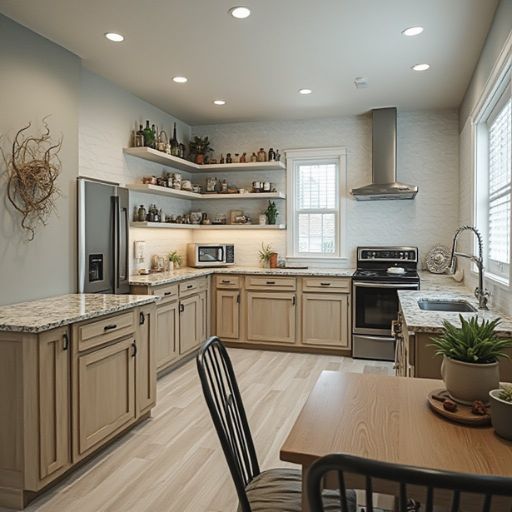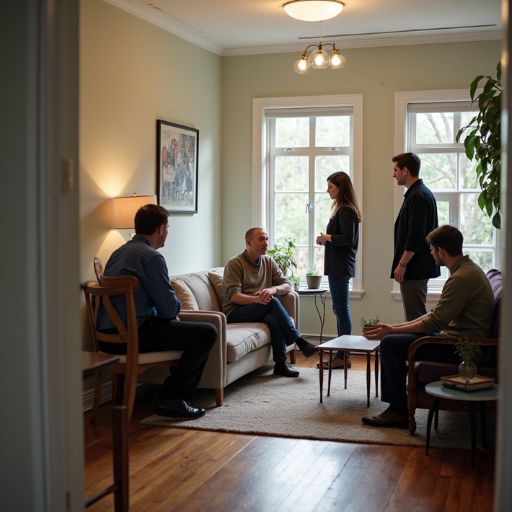Top 10 Mistakes Tenants Make (And How to Avoid Them!)
It’s astonishing how many tenants unknowingly set themselves up for stress and financial woes with simple missteps.
Imagine paying rent that devours half your paycheck or finding out your dream apartment is in a crime-ridden neighborhood.
These errors might seem minor but can greatly impact your peace of mind and wallet.
By addressing these common pitfalls, you guarantee a smoother renting experience.
Curious about avoiding these traps? Let’s explore smart strategies.

Not Giving Price Enough Consideration
Many tenants overlook the essential aspect of price when searching for a new place to live, often leading to financial strain.
Renting a home should empower you, not trap you in a cycle of debt.
A common mistake renters make is ignoring the significant lease terms that dictate your financial obligations.
Confirm your rent doesn’t exceed 30% of your income. This guideline helps maintain freedom and financial stability.
Aim for a monthly income at least 2.5 times your rent to comfortably cover expenses.
Don’t forget additional costs like utilities and groceries.
Renting Sight Unseen

Renting a property without seeing it in person can lead to unexpected surprises that virtual tours simply can’t capture.
While online listings might showcase a property’s highlights, they often miss vital details like water pressure, insulation quality, and any hidden damage.
Virtual Tours Limitations
Steering through the rental market through virtual tours might seem convenient, but it comes with notable limitations that you can’t ignore.
While virtual tours offer a glimpse into a rental property, they often fail to reveal critical details.
Professional photography can mask problems like water damage or poor insulation, which only become apparent during in-person visits.
It’s easy to be swayed by well-staged images, but signing a lease based on them alone may lead to unexpected surprises, like hidden utility costs from undetected issues.
You can’t assess the quality of plumbing or electrical systems virtually, and this oversight may cost you later.
For those who value freedom and want control over their living environment, remember: virtual tours aren’t foolproof.
Importance of In-Person Visits
Virtual tours may offer a convenient starting point, but they lack the depth of understanding that in-person visits provide.
When you physically step into a property, you can assess its true condition beyond what online listings show.
In-person visits empower you to identify pre-existing damage, such as mold or faulty plumbing, that virtual tours might gloss over.
This proactive approach helps you avoid potential hazards, especially since 35% of private rental properties are rated non-decent.
Property management can sometimes miss these issues, so your thorough inspection is essential.
Visiting at different times lets you gauge neighborhood safety and noise levels, contributing to informed decisions.
Prioritize freedom and peace of mind by ensuring your future home is truly as advertised.
Prioritizing Square Footage Over the Layout

When you’re choosing a rental, focusing solely on square footage can lead you to overlook how a smart layout can transform your living experience.
A well-connected and thoughtfully designed space can make a smaller apartment feel more open and functional than a larger one with poor room flow.
Layout Versus Usable Space
While it might be tempting to focus solely on square footage when choosing a rental, doing so can lead to unnecessary dissatisfaction.
A cleverly designed 700 sq. ft. layout can offer a more fulfilling rental experience than a cramped 850 sq. ft. space.
Prioritize how the layout accommodates your lifestyle and furniture. Imagine the flow between rooms and how it complements your daily routines.
Walking through the space in person is essential, as video tours often miss the nuances of a layout’s usability.
Evaluate storage options carefully; even smaller spaces can feel expansive with smart storage solutions.
Remember, it’s about how you live in the space, not just the numbers.
Choose wisely for a more liberating and enjoyable living environment.
Room Connectivity Importance
A well-connected layout can transform your rental experience, making it essential to prioritize room connectivity over sheer square footage.
Don’t get trapped by the allure of larger spaces that might feel cramped due to poor design.
Instead, during your in-person tours, visualize how the layout facilitates your daily movements and routines.
Consider open floor plans or direct access between key areas, which can greatly enhance comfort and functionality.
A rental with a thoughtful layout can adapt to your needs, whether you’re entertaining guests or setting up distinct living zones.
Before signing that lease agreement, verify the property supports a harmonious lifestyle, letting you move freely and live fully without being boxed in by an inefficient design.
Forgetting to Check Out the Neighborhood
How often do you think about the neighborhood before signing a lease?
Confirming neighborhood safety is vital for your peace of mind and freedom.
Start by researching local crime rates using resources like the Free Crime in the Area app or platforms like https://www.police.uk/.
These tools provide valuable insights into crime patterns, helping you assess if the area meets your safety standards.
Don’t overlook the power of engaging with neighbors.
A casual chat can reveal first-hand information about the community vibe and living conditions.
Visit at various times to experience different atmospheres and noise levels.
Around 10% of tenants feel unsafe in their surroundings, so take proactive steps to verify your new neighborhood is a haven, not a hindrance.
Ignoring Amenities

When you sign a lease, don’t overlook the amenities included in your rental agreement, as they greatly influence your comfort and satisfaction.
Assess the value of amenities like laundry facilities, pools, and fitness centers, and guarantee they align with your lifestyle needs and budget.
Balancing the cost of these features against their benefits helps you make a well-informed decision without sacrificing essential comforts.
Evaluating Included Amenities
Many tenants make the mistake of overlooking the vital role that included amenities play in shaping their rental experience and budget.
When renting, always review the rental agreement to pinpoint which amenities are included.
Overlooked amenities like laundry facilities, parking, and maintenance services can lead to unforeseen expenses.
Imagine the convenience of having an on-site fitness center or pool, enhancing your lifestyle and saving on gym memberships.
However, be mindful—some properties might charge extra for amenities like communal laundry services.
Prioritize the amenities that align with your lifestyle needs to maximize comfort and convenience.
By evaluating amenities wisely, you guarantee that you’re not only securing a place to live but also embracing a space that truly fits your lifestyle.
Weighing Costs Against Benefits
Why do so many tenants miss the opportunity to enhance their living experience by ignoring the true value of included amenities?
In the competitive rental market, it’s essential to avoid making hasty decisions that overlook these valuable features.
Amenities like laundry facilities and fitness centers often justify slightly higher rent by saving you time and money.
Minor amenities, such as parking spaces or communal gardens, can greatly boost your quality of life.
Properties with sought-after amenities not only maintain higher occupancy rates but also attract tenants willing to invest in a more comfortable lifestyle.
Weighing these amenities against rental costs can reveal hidden benefits, allowing you to make informed decisions that align with your desire for freedom and convenience.
Not Communicating Well With the Landlord

How often do you find yourself struggling to communicate effectively with your landlord?
It’s a common mistake not communicating well with the landlord, which can lead to misunderstandings and unsolved issues.
To avoid this, establish clear communication methods before signing the lease.
Make certain to document all communications—emails, texts, phone calls—to provide a reliable reference for agreements and repair requests.
This simple practice can save you from future disputes.
Document all communications to prevent disputes and ensure reliable reference for agreements and repairs.
Additionally, clarify who’s responsible for repairs and maintenance in the rental agreement.
This prevents unexpected costs and guarantees you know where responsibilities lie.
Open communication fosters a positive relationship with your landlord, potentially leading to better references and smoother living arrangements in future rentals.
Not Getting Renters Insurance

One of the most common oversights tenants make is skipping renters insurance, an essential safeguard for your personal belongings.
By investing just $100 to $300 annually, you protect against loss from theft, fire, or natural disasters.
Many landlords require renters insurance, so check your lease for specific requirements.
Without it, you’re left financially responsible for replacing lost or damaged items.
Here’s why renters insurance is vital:
- Affordable Protection: Covers your personal belongings at a minimal cost.
- Liability Coverage: Shields you from financial responsibility if a guest is injured.
- Peace of Mind: Guarantees you’re not shouldering hefty replacement costs alone.
- Comprehensive Security: Extends beyond your landlord’s insurance, which doesn’t cover tenant property.
Consider renters insurance to maintain your financial freedom.
Not Documenting Condition During Move-in

Before you settle into your new home, it’s crucial to document the property’s condition thoroughly.
Conduct a detailed walk-through to identify any pre-existing damages.
Take photos or videos of each room, focusing on visible issues, to create a visual record.
This step isn’t just about capturing images; it’s about securing your freedom from future disputes over your security deposit.
Craft a written report describing the property’s condition, including any damages you find.
Share this report with your landlord for mutual acknowledgment and make sure both parties sign and date it.
Paying Rent Late

After confirming your new home is documented thoroughly, it’s equally important to maintain a good financial standing by paying your rent on time.
Paying rent late can tank your credit score by up to 100 points and impact future opportunities.
Avoid the pitfalls of late fees and eviction risks by following these steps:
- Set Up Automatic Payments: Eliminate the hassle by automating payments, confirming you’re never late.
- Use Payment Reminders: Utilize digital reminders to keep rent due dates top of mind.
- Communicate with Your Landlord: If a delay is unavoidable, inform your landlord early to discuss flexible arrangements.
- Budget Wisely: Prioritize rent in your monthly budget to confirm timely payments.
These simple strategies preserve your freedom and financial future.
Taking on Roommates Without an Agreement

When you decide to bring a roommate into your living space, it’s crucial to formalize the arrangement with a written agreement.
A well-structured roommate agreement clarifies financial responsibilities, ensuring each person knows their share of the rent and utilities.
This avoids future conflicts and promotes harmony.
By detailing household duties, like cleaning schedules and grocery contributions, you foster accountability among roommates.
Ground rules about guests, noise levels, and shared spaces should also be included to prevent misunderstandings.
Discussing and documenting how to handle shared expenses, such as bills and communal supplies, keeps financial disputes at bay.
A written agreement acts as a reliable reference point, helping you address issues as they arise, ensuring everyone enjoys a balanced and free living environment.
FAQs
What Not to Say to Your Landlord?
When negotiating your lease, don’t threaten legal action or emphasize tenant rights aggressively. Maintain open communication strategies without suggesting you’re leaving soon. Such statements can hinder lease negotiations and damage the landlord-tenant relationship, limiting your freedom and options.
What Is the Most Important Responsibility of a Tenant?
Your most important responsibility as a tenant is paying rent on time. Understand your lease agreements, fulfill tenant obligations, and handle property maintenance diligently to maintain freedom from eviction and guarantee a harmonious relationship with your landlord.
How to Tell a Tenant to Move Out Nicely?
When asking a tenant to move out, break the ice by expressing appreciation. Use effective communication strategies to explain the tenant eviction process, ensuring clarity while maintaining positive relationships. Offer assistance and document everything for transparency.
What Do Landlords Fear?
You understand landlords’ fears of rental property concerns like non-payment and lease agreement violations. Implementing a thorough tenant screening process mitigates these risks, ensuring financial stability and peace of mind while respecting your desire for freedom and flexibility.
Final Thoughts
Avoiding tenant pitfalls is akin to steering through Scylla and Charybdis; it demands vigilance and wisdom.
Prioritize rent within your budget, and inspect your future home and its surroundings like a detective solving a mystery.
Remember, amenities and renters insurance are your allies, not afterthoughts.
Documenting property conditions is your shield against future disputes.
Finally, a roommate agreement is your peace treaty.
With these guiding principles, you’re not just renting a space—you’re crafting a harmonious living experience.